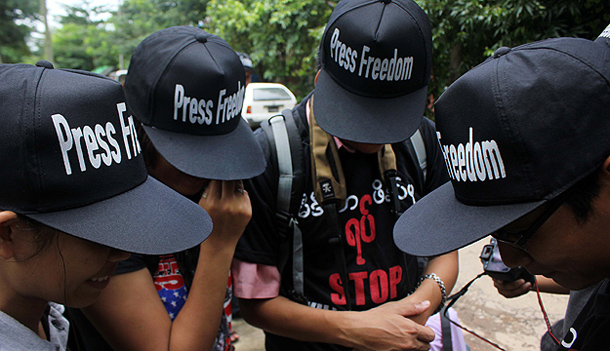No journalists were jailed in Burma this year for the first time since 1996, despite a record number being detained worldwide.
More journalists than ever are languishing in prisons across the globe, but a series of liberalizing measures in military-dominated Burma means that unprecedented levels of press freedom are currently being enjoyed, according to the New York-based Committee to Protect Journalists (CPJ).
As part of Burma’s historic transition to civilian rule, the authorities released more than a dozen imprisoned journalists in a series of pardons over the past year, as well as scrapping pre-censorship and drafting a new media law.
“Journalists have enjoyed being able to write freely about news stories that they were previously not allowed to write about after the abolishment of censorship in August,” Thiha Saw, editor of Open News journal, told The Irrawaddy on Wednesday.
“Compared to the 2007 Saffron Revolution protests, the recent Letpadaung protests could be covered in detail by journalists inside Burma. However, there are still journalists being charged or sued for reporting the news.
“If you compare five or one year ago, we have more freedom and next year we will have daily newspapers so reporters can work better,” he added. “There will be more freedom of expression in the future too, but there is still a need to abolish some laws, such as the Electronics Act and 1962 Printers and Publishers Registration Act.”
CPJ named Burma as the seventh worst country for press censorship in 2012—after Uzbekistan, Equatorial Guinea, Iran, Syria, North Korea and Eritrea—with the former pariah state in second place the previous year.
Similarly, Burma ranked 187 out of 197 countries in the world—38 out of 40 Asia-Pacific nations—in the Freedom of the Press 2012 report by Freedom House.
“Reporting now is free, smoother and better than before for there is no censorship board,” Pe Myint, editor-in-chief of the People’s Age journal, told The Irrawaddy. “ However, we have to report and produce news with caution for there are still some laws—regarding defamation, the Electronics Act and [Section 427 of the Penal Code] for threatening the peace and dignity of the nation—which bar the perfect freedom of the press.
“The problem is, for example, we do not know clearly that what kind of reporting is threatening the peace of the nation. Because, there have been many examples from the past of reporters being charged with those acts and spending many years in prison.
“There are still many things to do to promote the freedom of press, like enacting the media law and a law to protect media personnel,” he added.
CPJ identified 232 media workers behind bars worldwide on Dec. 1 this year—an increase of 53 over its 2011 tally and the highest number since surveys began in 1990. Countries such as Turkey, Iran and China were blamed for the record global detentions, with terror and other anti-state charges being used to silence critical reporting.
“CPJ believes that journalists should not be imprisoned for doing their jobs,” read a statement released by the group on Tuesday. “The organization has sent letters expressing its serious concerns to each country that has imprisoned a journalist. In the past year, CPJ advocacy led to the early release of at least 58 imprisoned journalists worldwide.”
Thirteen Democratic Voice of Burma reporters were released under President Thein Sein’s amnesty on Jan. 13, but still live with the threat of re-arrest.
All those freed in amnesties since 2011 have been granted conditional release under Section 401 of the Code of Criminal Procedure. Any prisoner who is subsequently deemed by the authorities to have breached these terms can be returned to prison to serve the remainder of their original sentence.
Meanwhile, government sources indicate that a revision to the 1962 Printers and Publishers Registration Act is likely to be debated in Parliament soon. The draconian legislation has been a key tool of media repression for Burma’s former military government.
The Irrawaddy reporters Zarni Mann and Nyein Nyein contributed to this article.

















